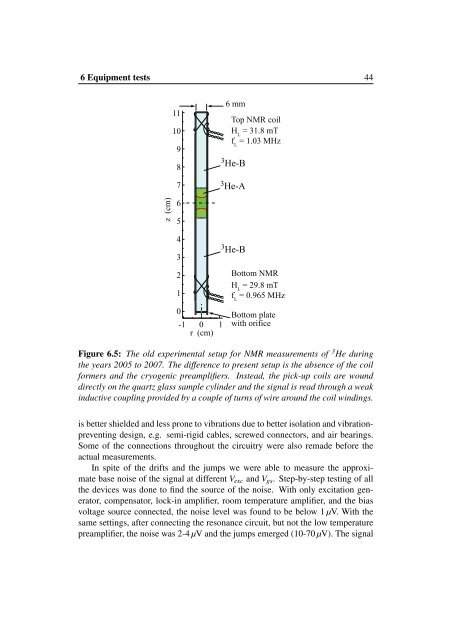NMR Techniques at Liquid Helium Temperatures - Low ...
NMR Techniques at Liquid Helium Temperatures - Low ...
NMR Techniques at Liquid Helium Temperatures - Low ...
You also want an ePaper? Increase the reach of your titles
YUMPU automatically turns print PDFs into web optimized ePapers that Google loves.
6 Equipment tests 44<br />
z (cm)<br />
11<br />
10<br />
9<br />
8<br />
7<br />
6<br />
5<br />
4<br />
3<br />
2<br />
1<br />
0<br />
-1 0 1<br />
r (cm)<br />
6 mm<br />
Top <strong>NMR</strong> coil<br />
H = 31.8 mT<br />
L<br />
f = 1.03 MHz<br />
L<br />
3 He-B<br />
3 He-A<br />
3 He-B<br />
Bottom <strong>NMR</strong><br />
H = 29.8 mT<br />
L<br />
f = 0.965 MHz<br />
L<br />
Bottom pl<strong>at</strong>e<br />
with orifice<br />
Figure 6.5: The old experimental setup for <strong>NMR</strong> measurements of 3 He during<br />
the years 2005 to 2007. The difference to present setup is the absence of the coil<br />
formers and the cryogenic preamplifiers. Instead, the pick-up coils are wound<br />
directly on the quartz glass sample cylinder and the signal is read through a weak<br />
inductive coupling provided by a couple of turns of wire around the coil windings.<br />
is better shielded and less prone to vibr<strong>at</strong>ions due to better isol<strong>at</strong>ion and vibr<strong>at</strong>ionpreventing<br />
design, e.g. semi-rigid cables, screwed connectors, and air bearings.<br />
Some of the connections throughout the circuitry were also remade before the<br />
actual measurements.<br />
In spite of the drifts and the jumps we were able to measure the approxim<strong>at</strong>e<br />
base noise of the signal <strong>at</strong> different Vexc and Vgs. Step-by-step testing of all<br />
the devices was done to find the source of the noise. With only excit<strong>at</strong>ion gener<strong>at</strong>or,<br />
compens<strong>at</strong>or, lock-in amplifier, room temper<strong>at</strong>ure amplifier, and the bias<br />
voltage source connected, the noise level was found to be below 1 µV. With the<br />
same settings, after connecting the resonance circuit, but not the low temper<strong>at</strong>ure<br />
preamplifier, the noise was 2-4 µV and the jumps emerged (10-70 µV). The signal

















